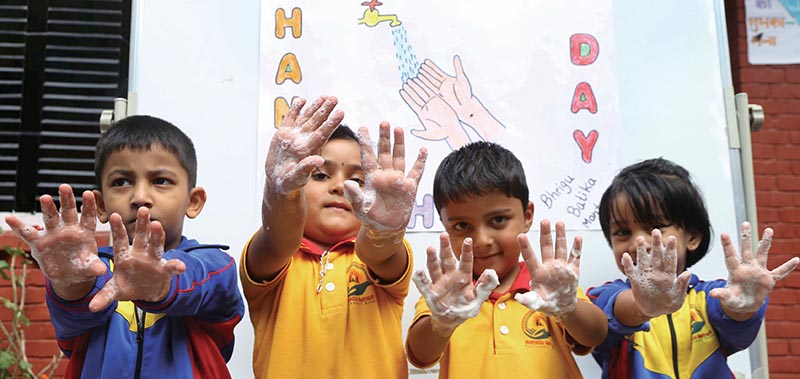Handwashing: A brief history and method
In 1846, when doctors and medical students delivered babies after coming back from the autopsy lab, the death rate of the postpartum women was found to be 18 per cent. This was drastically different when midwives (who did not go to the autopsy lab) performed these deliveries. The mortality rate with the midwives was only 1 per cent.
To solve this mystery, Dr. Ignaz Semmelwies of Hungary hypothesised that there must be something from the dead bodies that might be killing these women. To test this theory, he designed a simple experiment: Dr. Ignaz required that the doctors and students returning from the autopsy labs wash their hands with chlorinated limewater before entering the delivery room and after leaving the autopsy room. As a result of this intervention, the mortality of the postpartum women got reduced from 18 per cent to 3 per cent. This was an amazing reduction in the death rate! Dr. Ignaz concluded that there must be “particles'' that are transmitting from the autopsy room to the delivery room through these doctors’ hands. Since his time, many studies have proven that hand washing can lower the transmission of germs.
For long after Dr. Ignaz’s study, there was a popular belief amongst scientists and the public that germs are transmitted through miasma or air pollution. Some in the medical community were even offended that they were asked to wash hands, and Dr. Ignaz’s theory was rejected, which caused him to have a mental breakdown, ending up in a mental asylum before his death.
In 1854, almost 10 years later, Florence Nightingale implemented hand washing heavily during the Crimean war while taking care of the wounded soldiers. Her religious use of hand washing proved to save lives and lower infections, also suggesting that hand washing can lower infectious diseases. But it was not until the 1980s, when there was an increase in food-borne infectious outbreak and healthcare-associated infections in the United States that the importance of handwashing came to the spotlight. This was the time HIV, a novel and deadly virus of that time, was causing terror around the world. This forced the Centers of Diseases and Control (CDC) to give national guidance in the United States of America, recommending handwashing in a healthcare setting.
Even though handwashing is relatively new in medical sciences, the practice of handwashing has remained for ages in religious traditions. In Judaism, Islam, Sikhism and Hinduism, there are rules to clean hands before praying. And now, during the COVID pandemic, handwashing is on the spotlight again. In 2020, there is no doubt that handwashing can help us lower the rate of infectious diseases. In the fight against this coronavirus, it is clear that handwashing will help us “flatten the curve” so that the health system has enough capacity to treat the sick. This is specifically important in countries with weaker health systems like Nepal.
Since 2013, we have been teaching handwashing methods to children in rural Nepali schools and an orphanage, with a focus on long-term habit and behaviour development. We want to share with you what we have learnt and used over the years.
To wash hands correctly, we must understand two things:
- To get rid of all the germs, we must wash hands with soap and water for at least 20 seconds
- There are common areas that are missed during handwashing: between the fingers, below the thumb, and the nails.
Now that you understand the above important concepts, you can use this song we created to wash your hands for exactly 20 seconds. This song is in Danny Denzongpa’s popular Nepali tune, “Raato Raani”.
The original lyrics are:
“Raato raani fule jhai sanjha ma,
Timi fulyau kaleji majha ma,
Manko raharaaa…..tyu tyu..
Kaanchi lai ghumaune, Kathmandu sahara”
In the same tune, sing the following lyrics while washing your hands:
“Dhunchau haath saabun ra paani le,
Hunchau swasthya yo raamro baani le,
sabko rahara….tyu tyu….
Coronaa mukta hos hamrooo gau ghara”
That’s it! The song is catchy and fun, and using this song, we have noticed behaviour change in children. Washing your hands without stopping while singing this song guarantees that you will wash your hands for 20 seconds. While singing this song, you have to wash your hands appropriately.
Handwashing is cost-effective, it is very easy to learn, and it can save lives! Even with this knowledge, the biggest challenge in public health is how to get people to wash their hands and make it a habit. Changing behaviour and adding a new habit is difficult, but it is not impossible. Using catchy songs like this is one method to change behaviour. Not only during a pandemic like this one, bringing about behaviour change through handwashing will be useful in our day-to-day lives for the rest of our lives.
Dr. Ignaz and Florence Nightingale fought against the popular beliefs during their times to do the right thing and save lives. Now, it is our turn. Even when COVID is over, there will be many other infectious diseases in our society in the future, and if we invest in behaviour change today (especially teaching our children), it will definitely benefit us and our society in the future. So, what are you waiting for? Come on, let's sing the song, and let's wash our hands!
Alternatively, you can also use this Happy Birthday song while you scrub your hands.
Dr Kharel practiecs emergency medicine in the US and has a Masters in Public Health from Harvard while Mr Bhattarai is president of HAPSA-Nepal (Health Advancement Programmes to Serve All-Nepal) and has a MBA from Tribhuvan University.




